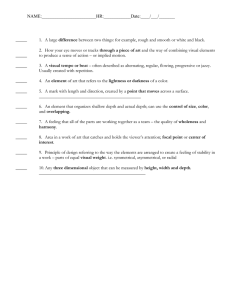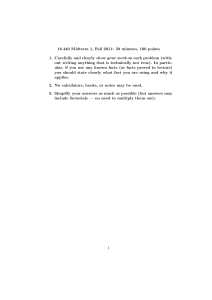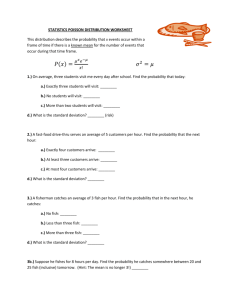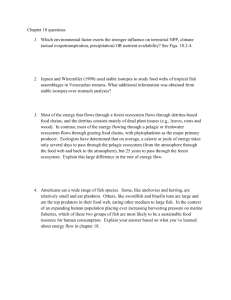':
advertisement
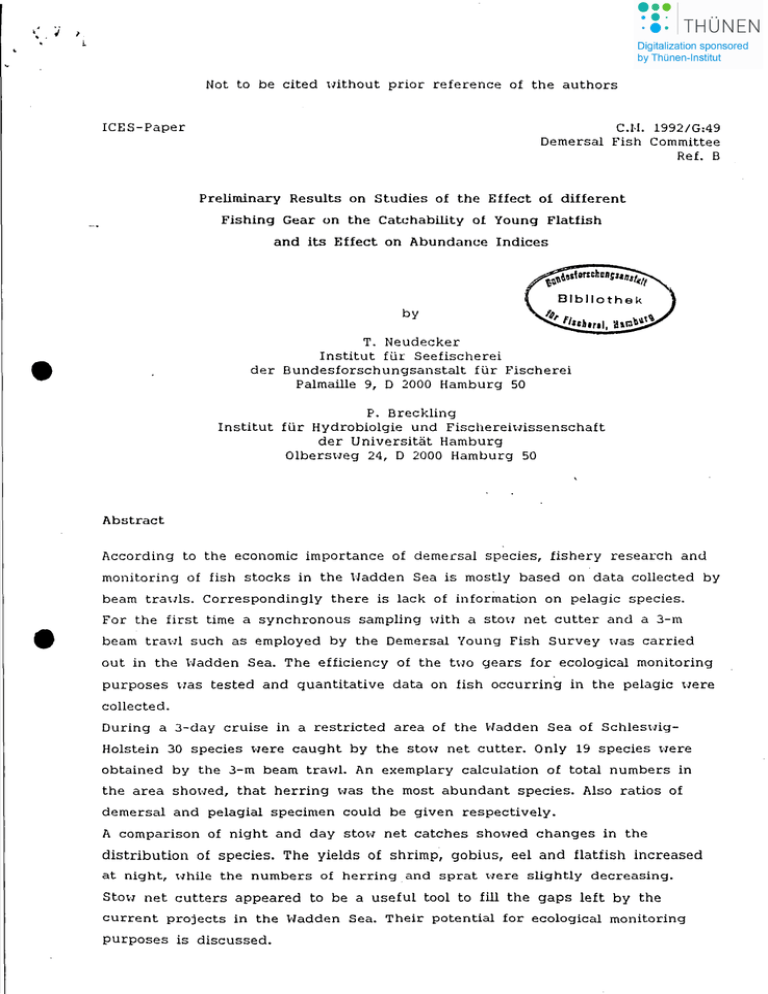
': _:) • } i. Not to be cited Hithout prior reference of the authors ICES-Paper C.H. 1992/G:49 Demersal Fish Committee Ref. B Preliminary Results on Studies of the Effect 01 different Fishing Gear on the Catchability 01 Young Flatfish and its Effect on Abundance Indices by T. Neudecker Institut für Seefischerei der Bundesforschungsanstalt für Fischerei Palmaille 9, D 2000 Hamburg 50 P. Breckling Institut für Hydrobiolgie und Fischereit-lissenschaft der Universität Hamburg OlbersHeg 24, D 2000 Hamburg 50 Abstract According to the economic importance of deme.csal species, fishery research and monitoring of fish stocks in the Hadden Sea is mostly based on data collected by beam trauls. Correspondingly there is lack of information on pelagic species. For the first time a synchronous sampling Hith a stou net cutter and a 3-m beam tra\-Jl such as employed by the Demersal Young Fish Survey Has carried out in the Hadden Sea. The efficiency of the tuo gears for ecological monitoring purposes \las tested and quantitative data on fish occurring in the pelagic \-lere collected. During a 3-day cruise in a restricted area of the Hadden Sea of SchlesHigHolstein 30 species were caught by the stO\-l net cutter. Only 19 species \-lere obtained by the 3-m beam traHl. An exemplary calculation of total numbers in the area shoHed, that herring Has the most abundant species. Also ratios of demersal and pelagial specimen could be given respectively. A comparison of night and day stOH net catches showed changes in the distribution of species. The yields of shrimp, gobius, eel and flatfish increased at night, Hhile the numbers of herring and sprat \-lere slightly decreasing. StoH net cutters appeared to be a useful tool to fill the gaps leit by the current projects in the Hadden Sea. Their potential for ecological monitoring purposes is discussed. 2 Introduction At present ÜlO programs are carried out in the German Hadden Sea by the Bundesforschungsanstalt für Fischerei (BFA) in Hamburg to collect data on the fish and crustacean fauna. The DEHERSAL YOUNG FISH SURVEY (DYFS) aims on the estimation of year class strengths of juvenile North Sea plaice and sole as early as possible for their use in the preparation of annual fishery management advice (VAN BEEK et a1. 1989). A second program is based on the investigation of the bycatch from the commercial shrimp fishery and provides trends of long term changes of species in the German Hadden Sea (TIEWS 1990, TIEHS & WIENBECK 1990). In both research programs beam tra\'ll catches are used for data collection, giving only pOOl' information on pelagic species. In the scope of the ecosystem research project in the Hadden Sea of SchlesuigHolstein (LEUSCHNER & SCHERER 1989) several fishing methods and gears are tested to gain information on their applicability and potential for ecological longterm observations. Tlae main purposes of these investigations are records of a11 present species including the pelagic ones. Furthermore it is intended to improve the estimates of total fish and crustaceans biomass as uell as total numbers in the Hadden Sea. This \'lill give information on the role of the species in the ecosystem and their present status. Also the knoHledge of specific ecological topics can be uidened. First changes in the species composition \lhich may be caused by global change effects are also included. In addition to beach seine and push-net (BRECKLING & BEERHANN-SCHLEIFF in press) several StOH nets are employed. In this paper the results of the first use of a StOH net cutter in the Hadden Sea are reported. A synchronous sampling Hith a 3-m DYFS beam traul t'las carried out, shoHing the potential of large StOH nets for monitoring purposes in comparison to a Hell established program. Material and methods Investigations \lere carried out in 1,leldorf Bight in the southern part of tbe National Park Schlesuig-Hoistein Hadden Sea (Fig. 1). This area is characterised by tidal flats tlith sandy and mixed sediments, Hhich are separated by tidal creeks Hith uater depths up to 15 m. Hud flats and pile tlorks cover the southern parts near the coast. The mean tidal range varies betueen 3.1 and 3.3 m, salinity ranged from 25 to 29 p.s.u. during the period of investigation. Sampling \las carried out from 22. to 24. of August 1991 at three stations (Fig. 1) llith both a stou net cutter and a beam traul vesse1. 1ft ' .' 3 Stow net catches Large stoH nets are used by the commercial fishery for different fishing purposes in large rivers and estuaries (see STERNER 1916, 1919, I,IOHR 1927, SCHNAKENBEK 1953, v. BRANDT 1959, KÜHL 1976). In the large rivers of Northern Germany mostly smelt, sturgeon, eel, salmon and ruffe uere caught >lith such gears. In the outer parts of the estuaries also herring and sprat \'lere important yields. In former times fishiny cruises \lere made to the island Helgoland in the German Bight, uhere a strong current betHeen the island and the associated Dune allotJed to handle StOH nets as \lell \lith excellent results (pers. comm. • RÜBCKE). In scientific programs the stOtv net is mostly applied for bait fishery to supply eelbaskets uith small fish. In this case the upper beam is placed near the surface, Hhile the loHer beam is located 1-2 m above the bottom. The 10Her beam can also be placed on the bottom, in case there are no or feH macroalgae or sand-megaripples drifting. The opening of the net is 90 m2 (9 has tvJO X 10 m), and it tunnels. I-lesh size in the cod end is 5,5 mm. Tt-JO current velocity meters placed in the opening of the net provide data on the tJater volume fished. StO\l nets catch all fish and crustaceans migrating Hith the tidal current. In research programs they have been employed uith different objectives for instance by PETERS et al. (1986), HöLLER (1988a, 1990) 01' NELLEN & HEIGELT (1991). In the Hadden Sea suitable fishing grounds can be found in tidal creeks t'lith Hater depths from 6 to 10 m at places Hith high tidal currents e. g. in front of steep slopes 01' narrotv passages betueen tidal flats 01' islands. The stou net is exposed one 01' tHO hours follot'ling tidal change. Fishing time may last 3 to 4 hours during ühich a volume of 450.000 to 1.000.000 m) can be fished. Hhile the cutter is at anchor, it is possible to Hork for 24 hours vJith fishiny periods of 3 to 4 hours every half tide. The standard catches are related to 1.000.000 m). Beam trawl catches The beam tra\'JI catches Here conducted with a 3-m beam traHI in the manner of the DYFS (VAN BEEK et al. 1989) during daytime. A total of 22 hauls was carried out near the stO\'l net cutter. The duration of hauls \las 15 minutes each. Water depths ranged from 3 to 12 metres. 4 Analysis of catches Total number of species A comparison of the number of species recorded by the different fishing methods shows the efficiency of the gears in describing accurately the species composition. This is needed for the detection of changes in species composition, for instance the invasion and settlement of lusitanic species. - Quantitative analysis Catches of the StOH net provide data on the number of Hsh and crustaceans migrating in and out of an area Hith the tidal current. They can be related to the volume of water flotving through the net. To compare these data \-lith results • of beam traHl catches, \'1hich are given as ind./lOOO m2 , He chose a method applicable to the specific conditions of the area investigated. For some regions of the German Hadden Sea the volume of uater floHing in and out through the tidal creeks is \-lell knoun. In some cases it is also possible to estimate the catchment area of a tidal creek. Then the total number of fish migrating in and out can be estimated from StO\>'1 net catches. The residual volume of v1ater in the tidal creek at low tide can be calculated from special maps of the Wadden Sea. H'hen the number of fish per residual volume is supposed to be equal to the number caught per volume with the stOH net, it becomes possible to calculate the total number of Hsh in the catchment area in a first approximation. The beam trawl catches include migrating and stationary individuals as well. These data mayaiso be projected on the catchment area, but it has to be taken into account whether or not the species concerned pertorm migrations to the tidal flats during daytime. The diurnal differences of StOH net catches give additional information on the diurnal change of distribution patterns of the species living in the Hadden Sea area. Results Record of species In total, the StOH net cutter caught 30 species, Hhile the beam trawl of the DYFS caught 19 species (Tab. 1). The stOH net catches during daytime are listed separately because the beam trawl catches Here carried out only during daytime. The most abundant species in the StOH net catches uere pelagic ones such as e 5 herring and sprat. But also demersal species such as plaice, sole, hook-nose, eelpout or buU-rout "tiere sometimes caught in high numbers. Lumpsucker, mackerei, scad and garfish mainly appeared in catches at station I (Fig. 1) \-lhich is located tOtvards the open North Sea, Hhile elose to the shore at stations II and III smelt, sole, plaice and \-lhiting uere caught in abundance. Quantitative comparison of stOH net and beam traul catches: The folloHing estimates of the catchment area of the Kronenloch (station II, Fig. 1), shaU serve as an example as the catchment areas and tidal volumes of stations II and III lo-lere not possible to detennine ad present state. The volume of vJater floHing in and out through the tidal creek at station II is 34 mio. m3 (ALH Heide, Department for Aquatic Sciences, pers. comm.) at each tide. The catchment area is estimated to be 11,4 km l ineluding 2,3 km l sublltoral habitat. The residual lo-later volume at lOH tide is assessed at 7 mio. m). The mean number of demersal Hsh specimen in the catchment area of station Ir is calculated from beam tralovl catches and the quantity of pelagic fish is raised from stolo., net catches (Tab. 2). The results shOtv, that herring ,-las the most abundant fish species in the catchment area of Kronenloch. Furtherrnore the ratio of specirnens staying elose to the bottorn and tlithin the Hater colurnn, respectively, is derived. Despite of the small number of hauls the distribution pattern of several species can be shoHn. During night-time the distribution of fish and crustaceans changes. Species knoHn to be demersal such as shrimps, gobies, eels and flatfishes use to rise into the pelagic and appeal' in higher numbers in the stOtv net catches, Hhile the numbers of pelagic species such as herring and sprat decreased slightly (Tab. III). Oue to the small number of hauls the data cannot be tested statistically. Discussion Large StoH nets have not been used in fishery research in the Hadden Sea before. The record of 30 Hsh species during a 3-day cruise at 3 stations in a relatively small area, Hhere a synchronöusly employed 3-m beam tra\VI caught 19 species, ShOHS the great efficiency of the StoH net for faunistic approaches. This can be underlined by a comparison with other studies carried out over longer periods in the Wadden Sea. HINZ (1989) caught 33 species, PIEPENBURG 6 (1984) 28 species, LILLELUND & BERGHAHN (1981) 33 species and BRECKLING & BEERHANN-SCHLEIFF (in press) 35 species. Their investigations lasted from 7 months to 2 years and several fishing methods such as commercial beam trauls for shrimps, fyke nets, beach seines or push nets have been used. Studying the bycatch of commercial beam-tratvlers from shrimp fishing grounds off Büsum (Fig. 1) in 1991, ACHENBACH & OPITZ (pers. comm.) found 27 species, t-lhile from the DYFS in the course of 18 years of investigation 41 species tIere reported in total, Hith some gobiid species missing as they Here reported by family only (NEUDECKER, T.; RAUCK, G. and H'IENBECK, H. 1990). The presented results of the 3-day cruise also demonstrate, that a research program 'tlith a special, clearly defined goal such as the DYFS does not go far enough tot-lards ansuering all fundamental questions of ecological concern. Fishing uith stou nets is less harmful for the benthic fauna and can be conducted Hith a minimum of acoustic disturbances caused by running engines, because the cutter is at anchor Hhile fishing. These are important aspects for . monitoring approaches in environmental protection areas such as national par)"s. Hore over the fish is in better eondition eompared to Hsh eaught by traul nets. Besides biological aspects it may be stated that the uorking conditions on deck all around the clock are mueh better than on commercial shrimp traulers. Therefore the stoH net cutter can be a useful tool for different research approaches of ecological interest as outlined by RUTH & BERGHAHN (1989). During this first preliminary survey the number of stOH net hauls Has tao small to perform statistical analysis. But each haul fished about 2~o of the total Hater volurne flouing in and out of the catchment area at station II (Kronenloch). Giving an example of the potential of the stOH net fishery in the Hadden Sea, the presented data should already be taken into account, and further methodological Hor)" 'tlill improve the quality of the estimates of total numbers of fish and crustaceans per area. The most considerable step fortlard is the improvement of the estimates of pelagic species stock sizes in the Hadden Sea by stou nets and the possibility to count demersal species migrating in the pelagic. Despite of being ;) basic tool for other fish stock assessment programs such as the SFB Tide-EIbe (NELLEN & HEIGELT 1991) the determination of fish stock size from StOtl net catches is not uithout problems. The projection of the catches on a fished Hater volume requires a passive drift of fish uith the tidal current. But it can be expected, that the fish compensate the effects of the current by suimming against it, especially in larger rivers. This may cause an underestimate of stock sizes. Furthermore the projection of catch data on a catchment area is a source 01 • ---~--~ .., I errors, uhich are estimated though to be in the same order of magnitude as for . beam traul catches. In principle the catches of at:tive and p"ssive gear are different and hard· to . . compare for quantifying analy·sis. But the Hay it i5 suggested and performed in 'this paper gives a first ~maginatio~ of theunderestimatlon of pelagic fish stocks in the Hadden Sea l-lhen' calculations are based ,on beam trat'll catches as, sl10un in Table 2. 'Ailoth~r important aspect is the, possibility to study dIurnal behavior patterns. It i I. ,. l_ I, I 1 is sometimes argued thai day ,catches of passive gear are regularly smallerthan , , " night, catches, because the fishes have a .better chance to notice the gear in time 'and escape.· The stou net fishery in the Hadden Sea hOt'lever i5 carried out . " at localities uith' the highest cllrrent velocitie::;, hign· turbiditi~s and Secchi-' . ' . depths being regularly less than' 1 depth,' giving ~eason for the m. , The fished Hater' column extends for 9 In as~umption gear visually should be of minor that escapes be:::iluse of noticing the importan~e" Furtherm~re the' numbe'~ of h~rring arid spra~" the most: abundant fish' sp'eci~s in the pelagic, tended to be even higher in our day catches (Tab. 3). These species may perform migrations on to the inundated tidal Hats during night-time. , For some species diur~al changes of the distribution patterns in the Hadden iI Sea, suchasshoun In this study, are alre'ady knouri in principle (HINZ 1989, ! KRUUK 1963, NELLEN, et al. in press., RUTH 'pers. comm.), though only feu (e.g. I ,I BERGHAHN 1986) quantitative analyses are found in literature. I In' ~pite of the small numbers of hauls in this study, clear trends are already observable, and the importance' of the pelagic, espeCially 'during nighl-time, requir~s 'möreinyestigations of this habitat. This, uill' alsu lead to a better u'nderstanding of relationships t-rithin the food ueb of the, . Hadden . Sea.' Il~ ~onclusion, stou' ~et tfshery could serve as an additi~nal, useful tool fer an i ecological :monitoring of the coastal fish 'fauna 'and help to fill a gap of ecolögical I kno\'l1edge left by the long time-series of the DYFS and bycatchin'vestigations. I It may cilso. be one mean to elaborate correction tactors, for the' species I I abundance indices found in routine programs like theDYFS. and used for stock I' assessment , , purposes~ i I.. I I I '. -. , , '< 8 .,, . References BEEK, F. A. van, RIJNSDORP, A. D. & CLERCK, R. de (1989): Honitoring juverlile stocks of flatfish in the Wadden ~ea' and the _coastal areas of the southeastern North Sea.- Helgol. 1.leeresuriters. 43 (3-4): 461-477 BERGHAHN, R. (1986): Determining abundance, distribution and mortalityof 0group _plaice (Pleuronectes' plätessa L.) in the Hadden Sea.- J. appl. Ichth. 2: 1122 . BRAND'!',' A. VOll (1959): Fanggeräte der Kuttei- und Küstenfischerei.Schriftenreihe des AID 113: 51-63 BRECKLING, P.' & BEERHANN-SCHLEIFF, S. (in press): Kartierung des Vor)<ominens von -Fischen und Krebsen in _Prielen des Schlesuig-Holsteini::;cheo' \Jattenmeeres.2. uissenschaftliches Symposium Ökosystemforschullg Hattenmeer, 4.-5. ),lärz, Büsum ' . . HINZ, V. (1989): 1,10nitoring the fish fauna in the Hadden Sea uith special' reference to different fishing methods and effects of \lind and light on catches.Helgol. Heeresunters. 43 (3-4): 447-459 KRUUK, H. (1963): Diurnal periodicity in the activity of the Common Sole, Solca vulgaris, Quensel.- Neth. J. Sea 'Res. 2: 1-28 , KOHL, H. (1976): Zum Stand der Hamenfischerei in der Unterelbe.- Neues Archiv' für Niedersachsen 25 (4): 315-324 LEUSCHNER, C. & SCHERER;. B. (1989): Fundamentals of an applied ecosystem - research project in the liadden Sea cf Schies\lig-Holstein.- Helgo,I. I-!eeresunters. 43, (3-4): 565:-574 LILLELUND, K. & BERGHAHN, R. (1981):' Gutachten zur Fischereibiologie der Nordstrander Bucht - Kur::fassung.- SchrReihe Landesreg. Schl~s\1.-Holst. 12: 251-312 , l-IÖLLER, H. (1988a): Fischbestände und Fischkrankheiten in der Unterelbe.J.1öller, Kiel, 344 pp. BÖLLER, H. (l990): Association bet\leen ctiseases of flounder (PI.3.t1chtllys flesusj and environmental conditions in the EIbe estuary, FRG.- J. Cons. int. E>:plor. l1~r 46: 107-199 BOHR, E. (1927): Die Fischerei in den Schlest:ig-Holsteinischen , Nordelbingen 6 Küstellg~t1ässern.­ NELLEN,H., HERRliANN, J.-P., PAC, G. & TEUl·IING, A. (in press;: Sylter \latterimeer Austausch-Prozesse, Teilprojekte Nekton.- 2., uissenschaftliches Symposium ökosystemforschung Hattenmeer, 4.-5. l·Iärz, Büsum NELLEN, H.' & UEIGELT, H. (1991): Fische.- Tätigkeitsbericht SFB 327 (Tide-EIbe) 1989-1991 9 NEUDECKER, T., RAUCK, G. & HIENBECK, H. (1989): Fischereibiologische Arbeiten des Instituts für Küsten- und Binnenfischerei im Bereich der neu geschaffenen Nationalparks des deutschen Hattenmeeres. Poster presented at the symposium "Nordseeforschung als Beitrag zum Schutz der Nordsee" held at Bremerhaven, Fed.Rep. of Germany, June 26.-28. 1990, unpublished. PETERS, N., SCHHIDT, H., GERCKEN, J., KRANZ, H. & HATERlvIANN, B. (1986): Die __ . Fische der Untereibe im Vergleich der Jahre 1894 und 198:! - eine Richtigstellung.- Arch. FischVIiss. 36: 287-304 PIEPENBURG, D. (1984): Zum Auftreten von Fischen und Fischnährtieren in ausgeHählten Prielen des Nordfriesischen Hattenmeeres.- Dipl.-Arb., Univ. Kiel: 184 pp. RUTH, H. & BERGHAHN, R. (1989): Biological monitoring of fish and crustaceans in the Hadden Sea - potential and- problems.- Helgol. lleeresunters. 43 (3-4): 479487 SCHNAKENBEK, H. (1953): Die deutsche Seefisc:herei.- Kröger, Hamburg, 470 pp. STERNER, E. (1916): Die Niederelbische Küstenfischerei.- Fischerbote 8: 190-195 STERNER, E. (1919): Die Niederelbische Küstenfischerei.- Fischerbote 11: 17-22 TIEl-lS, K. (1990): 35-Jahres-Trends (1954-1988) der Häufigkeit von 25 Fisch- und Krebstierbeständen an der deutschen Nordseeküste.- Arch. FischHiss. 40 (1/2): 39-48 TIEHS, K. & HIENBECK, H. (1990): Grundlagenmaterial zu "35-Jahres-Trends (1954-1988) der Häufigkeit von 25 Fisch- und Krebstierbeständen an der deutschen Nordseeküste" .- Veröff. d. Inst. f. Küsten- u. Binnenfischerei Hamburg 103, 64 pp. ., -~ 10 Table 1: Fish species caught in the "Heldorfer Bucht" in August August 1991 in the order of abundance in the total stow net catches Species Herring (Clupea harengus) Sprat (Sprattus sprattus) Smelt (Osmerus eperlanus) Sand goby (Pomatoschistus minutus) I) L. pipe-fish (Syngnathus rostellatus) Sole (Solea solea) Plaice (Pleuronectes platessa) Scad (Trachurus trachurus) Dab (Limanda limanda) Hook-nose (Agonus cataphractus) Whiting (Herlangius merlangus) Grey gurnard (Trigla gurnardus) Stickleback (Gasterosteus aculeatus) Flounder (Platichthys flesus) Common goby (Pomatoschistus microps) I) Twaite shad (Alosa fallax) Sandeel (Ammodytes tobianus) Eel (Anguilla anguilla) Cod (Gadus morhua) Lumpsucker (Cyclopterus lumpus) Eelpout (Zoarces viviparus) Bullrout (Hyoxocephalus scorpius) Hackerel (Scomber scombrus) Lampern (Lampetra fluviatilis) Gunnel (Pholis gunellus) 5-bearded rockling (Ciliata mustelaJ Brill (Scophthalmus rhombus) Garfish (Belone belone) Dragonet (Callionymus lyra) Sea snail (Liparis liparis) Number of species Stow net (total) Stow net (day) 3-mbeam trawl x X X X X X X X X X X X X X X X X X X X X X X X X X X X X X X X X X X X X X X X 30 X X X X X X X X X X X X X X X X X X X X X X X X X X X X X X X X X X X 26 19 I)Gobiidae from 3-m-beam-trawl catches were not determined by species 11 - - - ~ I I Table 2: ' Ule~sMv:n~ 6., I I 1 . - .... - - I - - r---'--->-----., f i g. ..... .. -:." I - - - - sand '" Sampling sites at the Neldorf Bight (+++ = catchment area of Station 11) Total numbers of fish and crustaceans of selected species in the catchment area of station 11 (Kronenloch) calculated from beam trawl catches and stow net catches Species Number in the catchment area of the Kronenloch 3-m beam trawl (3-6 hauls) Herring Swimming crab Smelt ~lhi ting Sand goby Plaice Ratio demers. :pelag. specimens Stow net (1-3 hauls) 1 653 382 407 1 200 116 330 575 640 1 5 35 226 110 618 1 3 1 445 492 3 1 51 756 2 378 20 1 025 250 1 242 326 1 r - - - - - - - - - - - - -------- - - - --------------- . 12 Table 3: Comparison of day (0) and night (_) stow net catches in the "Meldorfer Bucht" (Ind/mio mJ and kg/mio ro J , 2-4 hauls) « < difference > factor 10 difference > factor 2 < factor 10 difference < factor 2 Species StO\~ net StO\'l net night day Shrimp « 0 Sand goby « 0 106 Sole 1 185 0 -< 212 Plaice - 263,4 kg 22,1 kg 0 -< I -I 307 Flounder 724 0 -< 45 Eel 0 -< 6 \'1hiting 0 -< 62 Smelt 0 == 2 492 Herring 0 "'- 0 23 370 == 13 111 0 14 088 - 134 21 277 21 162 Swimming crab - 3 825 40 559 Sprat 851 "'- 18 084 ..--
